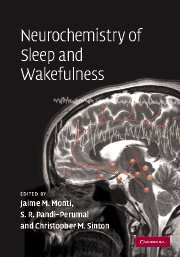Book contents
- Frontmatter
- Contents
- List of contributors
- Preface
- Acknowledgements
- Abbreviations
- I The neurochemistry of the states of sleep and wakefulness
- II The influence of neurotransmitters on sleep and wakefulness
- III Changing perspectives
- 10 Melatonin and its receptors: biological function in circadian sleep–wake regulation
- 11 Sleep regulatory factors
- 12 Adenosine and sleep–wake regulation
- 13 Prostaglandins and the regulation of sleep and wakefulness
- 14 Neuropeptides and sleep–wake regulation
- 15 Orexins in sleep and wakefulness: rodent models of narcolepsy–cataplexy
- 16 The relevance of experimental pharmacology to currently available sleep–wake therapeutics
- Index
- Plate section
16 - The relevance of experimental pharmacology to currently available sleep–wake therapeutics
from III - Changing perspectives
Published online by Cambridge University Press: 23 October 2009
- Frontmatter
- Contents
- List of contributors
- Preface
- Acknowledgements
- Abbreviations
- I The neurochemistry of the states of sleep and wakefulness
- II The influence of neurotransmitters on sleep and wakefulness
- III Changing perspectives
- 10 Melatonin and its receptors: biological function in circadian sleep–wake regulation
- 11 Sleep regulatory factors
- 12 Adenosine and sleep–wake regulation
- 13 Prostaglandins and the regulation of sleep and wakefulness
- 14 Neuropeptides and sleep–wake regulation
- 15 Orexins in sleep and wakefulness: rodent models of narcolepsy–cataplexy
- 16 The relevance of experimental pharmacology to currently available sleep–wake therapeutics
- Index
- Plate section
Summary
Introduction
Determining the underlying therapeutic mechanisms of a drug makes pharmacology a powerful tool for understanding biological phenomena. This chapter reviews the preclinical evidence of the impact of some neurotransmitter systems and related drugs on sleep and wakefulness.
GABA-A and sleep
A series of neurotransmitter systems are responsible for maintaining wakefulness, including norepinephrine (NE), serotonin (5-HT), acetylcholine (ACh), dopamine (DA), excitatory amino acids, hypocretins (i.e. orexins), and histamine (Mendelson 2001; Monti and Jantos 2004; Salin-Pascual et al. 1999; Ursin 2002; Sakurai 2005). Delta sleep, or non-REM sleep, is related to adenosine, GABA, and prostaglandins, among others (Ekimova and Pastukhov 2005; Hayaishi and Matsumura 1995; Johnston 2005; Koyama and Hayaishi 1994). Finally, ACh has a prominent role in rapid eye movement (REM) sleep, together with 5-HT, NE, and hypocretin; these three molecules inhibit cholinergic and cholinoceptive neurons, which are implicated in the initiation of this sleep stage (McCarley 2004; Reinoso-Suarez et al. 2001).
GABA, and molecules that act at GABA-A receptors, have been classically recognized as hypnotics (i.e. benzodiazepines) and anesthetics (i.e. barbiturates). Benzodiazepine (BZD) receptors, a modulatory site on the GABA-A receptor, were discovered in the 1970s. Like other sites on the GABA-A receptor complex, these receptors work allosterically, cooperatively modifying channel permeability to chloride ions.
- Type
- Chapter
- Information
- Neurochemistry of Sleep and Wakefulness , pp. 433 - 461Publisher: Cambridge University PressPrint publication year: 2008



